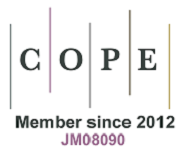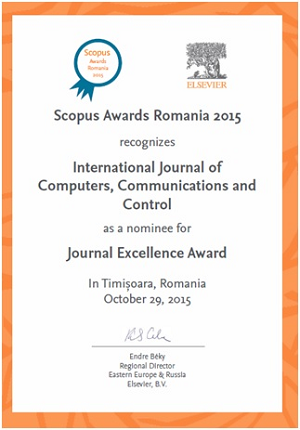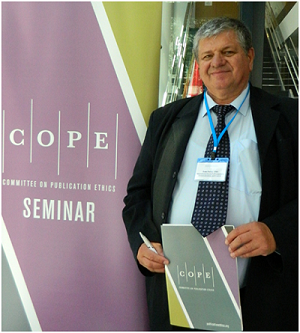Fuzzy Local Trend Transform based Fuzzy Time Series Forecasting Model
Keywords:
time series forecasting, fuzzy time series, trend, transformAbstract
A fuzzy local trend transform based fuzzy time series forecasting model is proposed to improve practicability and forecast accuracy by providing forecast of local trend variation based on the linguistic representation of ratios between any two consecutive points in original time series. Local trend variation satisfies a wide range of real applications for the forecast, the practicability is thereby improved. Specific values based on the forecasted local trend variations that reflect fluctuations in historical data are calculated accordingly to enhance the forecast accuracy. Compared with conventional models, the proposed model is validated by about 50% and 60% average improvement in terms of MLTE (mean local trend error) and RMSE (root mean squared error), respectively, for three typical forecasting applications. The MLTE results indicate that the proposed model outperforms conventional models significantly in reflecting fluctuations in historical data, and the improved RMSE results confirm an inherent enhancement of reflection of fluctuations in historical data and hence a better forecast accuracy. The potential applications of the proposed fuzzy local trend transform include time series clustering, classification, and indexing.References
L. A. Zadeh, Outline of a New Approach to the Analysis of Complex Systems and Decision Processes, IEEE Trans. Systems, Man,and Cybernet, Vol.3, No.1, pp.28-44, 1973. http://dx.doi.org/10.1109/TSMC.1973.5408575
L.A. Zadeh, The Concept of a Linguistic Variable and its Application to Approximate Reasoning, Part 1, Information Sciences, Vol.8, No.3, pp.199-249, 1975. http://dx.doi.org/10.1016/0020-0255(75)90036-5
Q. Song, B. S. Chissom, Fuzzy Time Series and its Model, Fuzzy Sets and Systems, Vol.54, No.3, pp.269-277, 1993. http://dx.doi.org/10.1016/0165-0114(93)90372-O
Q. Song, B. S. Chissom, Forecasting Enrollments with Fuzzy Time Series -Part I, Fuzzy Sets and Systems, Vol.54, No.1, pp.1-9, 1993. http://dx.doi.org/10.1016/0165-0114(93)90355-L
Q. Song, B. S. Chissom, Forecasting Enrollments with Fuzzy Time Series -Part II, Fuzzy Sets and Systems, Vol.62, No.1, pp.1-8, 1994. http://dx.doi.org/10.1016/0165-0114(94)90067-1
S. M. Chen, Forecasting Enrollments based on Fuzzy Time Series, Fuzzy Sets and Systems, Vol.81, No.3, pp.311-319, 1996. http://dx.doi.org/10.1016/0165-0114(95)00220-0
K. H. Huarng, Heuristic Models of Fuzzy Time Series for Forecasting, Fuzzy Sets and Systems, Vol. 123, No.3, pp.369-386, 2001. http://dx.doi.org/10.1016/S0165-0114(00)00093-2
C. H. Cheng et al, Trend-weighted Fuzzy Time Series Model for TAIEX Forecasing, Lecture Notes in Compter Science, Part III, Vol.4234, pp.469-477, 2006. http://dx.doi.org/10.1007/11893295_52
S. M. Chen, N. Y. Wang, Fuzzy Forecasting based on Fuzzy-trend Logical Relationship Groups, IEEE Trans. Systems, Man, and Cybernetics-Part B: Cybernetics, Vol.40, No.5, pp.1343 - 1358, 2010.
H. Y. Jung et al, Fuzzy Time Series Reflecting the Fluctuation of Historical Data, Seventh International Conference on Fuzzy Systems and Knowledge Discovery, pp.473-477, 2010. http://dx.doi.org/10.1109/fskd.2010.5569765
J. Dan et al, Mean local trend error and fuzzy-inference-based multicriteria evaluation for supply chain demand forecasting, Journal of Advanced Computational Intelligence and Intelligent Informatics, Vol. 15, No. 2, pp.134-144, 2011.
J. R. Hwang et al, Handling Forecasting Problems Using Fuzzy Time Series, Fuzzy Sets and Systems, Vol.100, No.1-3, pp.217-228, 1998. http://dx.doi.org/10.1016/S0165-0114(97)00121-8
C. H. Cheng et al, Multi-attribute Fuzzy Time Series Method based on Fuzzy Clustering, Expert Systems with Applications, Vol.34, No.2, pp.1235-1242, 2008. http://dx.doi.org/10.1016/j.eswa.2006.12.013
H. K. Yu, A Refined Fuzzy Time Series Model for Forecasting, Physica A, Vol.346, No.3/4, pp.657-681, 2005. http://dx.doi.org/10.1016/j.physa.2004.07.024
K. H. Huarng, H. K. Yu, Ratio-based Lengths of Intervals to Improve Fuzzy Time Series Forecasting, IEEE Trans. Systems, Man, and Cybernetics-Part B: Cybernetics, Vol.36, No.2, pp.328-340, 2006.
J. C. Bezdek et al, FCM: The Fuzzy C-means Clustering Algorithm, Computers & Geosciences, Vol.10, No.2-3, pp.191-203, 1984. http://dx.doi.org/10.1016/0098-3004(84)90020-7
J. R. Hwang et al, Handling Forecasting Problems Using Fuzzy Time Series, Fuzzy Sets and Systems, Vol.100, No.1-3, pp.217-228, 1998. http://dx.doi.org/10.1016/S0165-0114(97)00121-8
A. Udechukwu et al, Discovering All Frequent Trends in Time Series, The 2004 winter international symposium on information and communication technologies, pp.1-6, 2004.
C. H. Chen et al, Mining Fuzzy Frequent Trends from Time Series, Expert Systems with Applications, Vol.36, No.2, Part 2, pp.4147-4153, 2009.
I. Z. Batyrshin, L. B. Sheremetov, Perception-based Approach to Time Series Data Mining, Applied Soft Computing, Vol.8, No.3, pp.1211-1221, 2008. http://dx.doi.org/10.1016/j.asoc.2007.02.020
K. H. Huarng, Effective Lengths of Intervals to Impove Forecasting in Fuzzy Time Series, Fuzzy Sets and Systems, Vol.124, No.3, pp.387-397, 2001. http://dx.doi.org/10.1016/S0165-0114(00)00057-9
Published
Issue
Section
License
ONLINE OPEN ACCES: Acces to full text of each article and each issue are allowed for free in respect of Attribution-NonCommercial 4.0 International (CC BY-NC 4.0.
You are free to:
-Share: copy and redistribute the material in any medium or format;
-Adapt: remix, transform, and build upon the material.
The licensor cannot revoke these freedoms as long as you follow the license terms.
DISCLAIMER: The author(s) of each article appearing in International Journal of Computers Communications & Control is/are solely responsible for the content thereof; the publication of an article shall not constitute or be deemed to constitute any representation by the Editors or Agora University Press that the data presented therein are original, correct or sufficient to support the conclusions reached or that the experiment design or methodology is adequate.







